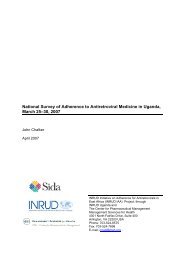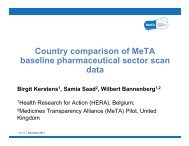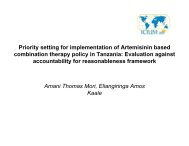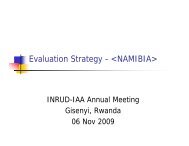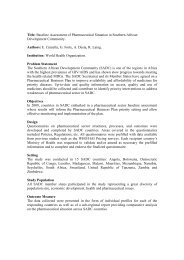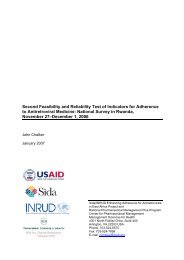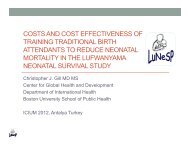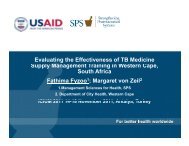How to investigate levels of Adherence to antiretroviral ... - INRUD
How to investigate levels of Adherence to antiretroviral ... - INRUD
How to investigate levels of Adherence to antiretroviral ... - INRUD
You also want an ePaper? Increase the reach of your titles
YUMPU automatically turns print PDFs into web optimized ePapers that Google loves.
9<br />
CHAPTER 9 --- Interpretation <strong>of</strong> data and followon<br />
questions<br />
The pattern <strong>of</strong> survey results may give clues as <strong>to</strong> the reason for poor adherence at that<br />
facility and therefore help <strong>to</strong> guide appropriate interventions <strong>to</strong> improve the situation. It is<br />
important <strong>to</strong> present the results <strong>to</strong> key stakeholders and discuss the reasons for the results.<br />
Remember that the results are only indica<strong>to</strong>rs and in themselves only suggestive; the<br />
reasons need investigating. For all the retrospective data, the results depend on record<br />
keeping, and the problem may be nothing <strong>to</strong> do with patient behaviour but due <strong>to</strong> poor<br />
record keeping. One must not rush <strong>to</strong> judgement. Whenever feedback is given, start with positive<br />
findings. When being critical, be constructive.<br />
The key adherence indica<strong>to</strong>rs that related <strong>to</strong> clinical outcomes were the five core indica<strong>to</strong>rs<br />
chosen and reported on here:<br />
1. Percentage <strong>of</strong> patients with full self-reported adherence in last three days (from exit<br />
interview)<br />
2. Average percentage <strong>of</strong> days covered by medicine dispensed over six months<br />
3. Percentage <strong>of</strong> patients with ≥ 30 days gap in medicines dispensed<br />
4. Percentage <strong>of</strong> patients attending clinic appointment as scheduled<br />
5. Percentage <strong>of</strong> patients attending clinic within three days <strong>of</strong> appointment<br />
Alternate indica<strong>to</strong>rs 6 and 7:<br />
6. Percentage <strong>of</strong> all visits in the last six months made before the days <strong>of</strong> medicine supplied at the<br />
previous visit have been consumed<br />
7. Percentage <strong>of</strong> all visits in the last six months made within 3 days <strong>of</strong> when the medicine<br />
supplied at the previous visit have been consumed<br />
These may present with different patterns <strong>of</strong> results which may suggest different causation<br />
that should be <strong>investigate</strong>d. Examples <strong>of</strong> results’ patterns—<br />
If indica<strong>to</strong>r 2 is high and indica<strong>to</strong>r 3 is low (most days covered by medicine<br />
dispensed and very few gaps <strong>of</strong> 30 days or more)<br />
These results show that patients are receiving their medicine correctly and people are<br />
therefore attending the clinic when they should be. This is encouraging, but all these results<br />
really show is that the patients are receiving their medicines - but it does not mean that they<br />
are taking them correctly. A facility in the Uganda feasibility study showed the average<br />
89



